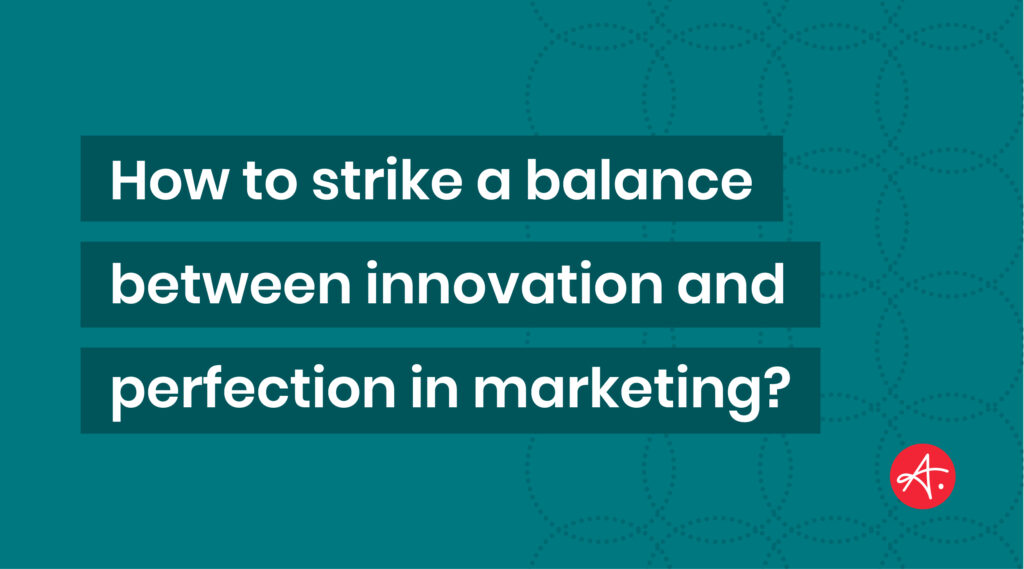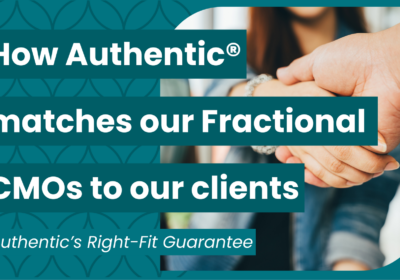
There’s a delicate balance between progress and perfection in marketing. When businesses strive for perfection, decision-by-consensus slows or stalls efforts. Innovative products, campaigns, and services never make it to market, or a competitor launches their offering first, diluting your offering and investments. On the flip side, there’s a risk of moving too quickly and promising something that the business can’t deliver on or launching something that doesn’t meet customers’ needs. Failing to deliver on a promise erodes stakeholder confidence and trust.
Striking a balance between speed to market and launching a thoroughly vetted offering is about managing risk, overcoming fear, and staying agile. We know firsthand the challenge of determining when something is “good enough” to release to customers and how to navigate organizations whose default mode is perfection. We turned to three Authentic Fractional CMOs for advice on how to stay competitive with confidence, agility, and innovation.
Q1: Some businesses fall into the trap of trying to perfect products or services before bringing them to market. What are the business risks of striving for perfection?
Katie: Strategically, they risk not being first to market and losing the first-mover advantage. For a novel solution, this can make the investment go flat. The other risk is that you miss a chance to help customers solve problems. If you wait until all the features are in place to go to market instead of identifying a minimum viable product and iterating from there, the core problem your product targets will go unsolved. By getting really focused on the core problem the new offering solves — and addressing that really well — you can go to market sooner and iterate the features that solve for more “edge” use cases.
Kelly: You have to balance speed to market against costs. Overthinking during development in an effort to perfect a product or service ultimately increases production costs and impacts your profits. Utilize existing voice of customer feedback to do a trade-off analysis and determine what attributes are most important to the end- user. Consider what is a “nice to have” versus a “need to have.” Oftentimes you miss the mark by overcomplicating it. Essentially, ask what’s the most acceptable version? Keep the end goal and end-user in mind; what problem will your product or service solve? Don’t concede on quality, but don’t over-engineer it by striving for perfection. There is a trade-off in quality or profit. Finally, it’s critical for some businesses to be first to market in order to maintain their market leader position, especially if innovation is their competitive advantage.
Jim: It depends on the product or service. Obviously, a medical device should be perfect. Non-regulated businesses have to adapt so much faster now, that as long as they assess the risks and are clear on what the product “story” is (target audience, features and benefits), they can trickle it out in a mini-test phase. I recently helped a client launch a “virtual standing meeting” to replace regular, in-person weekly visits. We were able to move fast by giving the initiative a name and creating a launch email for the sales team to use with their top customers. The downside risk was very low, so the effort didn’t require hours of meetings or multiple review cycles.
Q2. There’s a difference between casting an aspirational vision and making a promise — but sometimes businesses confuse the two. What are the risks of making a promise the company can’t deliver on? How have you seen companies stumble through this?
Kelly: Brand loyalty is built on consistently meeting client expectations. If you overpromise, you will lose credibility. Companies that state their long-term vision should also highlight key milestones charting towards that vision. Share how you are being innovative but do not promise or overstate where you are at in the process. It’s critical to set expectations and be transparent in how you will deliver along the way. Companies should also communicate how they are tracking against those milestones and where they have met or exceeded expectations in the process of achieving the vision. I have seen companies share their vision statements, but they did not communicate accomplishments along the way. If you do not provide updates on the vision, people – both employees and customers — will lose faith in your brand.
Jim: I have seen a company hype and prematurely launch a newly engineered fishing reel because the President wanted it out early, even though it wasn’t ready. The product tanked and, even with revisions, it was so severely tainted that it never saw the light of day. Marketing made it pretty, but it didn’t perform. Testing and customer feedback have to mesh with the risk. Customers expect brands to deliver on their promises.
Katie: I’ve been in businesses that work hard to incorporate customer input into every phase of development through advisory boards, beta users, and co-creation with users. This user-centered innovation requires a level of transparency about the types of problems you’re aspiring to solve but not necessarily about the specific solution you are developing. Ultimately, this can bring you to a more effective and helpful offering.
Once, though, we put a specific vision into the market before we understood the technical complexity and never launched the offering. In that case, the worst damage wasn’t in customer perception; we took a huge hit in the trust our field channel had for the business. That stakeholder group is paying attention to everything and deserves to know you’ve vetted a concept for viability before it makes its way into a vision or a promise.
Q3: What advice can you offer businesses to maintain a balance between constant progress without being hindered by striving for perfection? What are some strategies to use to maintain momentum and focus?
Jim: Do your upfront strategy work in advance. Assess the marketplace and develop products, services, or updates to them, utilizing marketing’s strategic input. We must be the “keeper of the customer,” and just because a company desires revenue doesn’t mean a customer will buy or advocate for a substandard product. Marketing, engineering, sales, ops, and finance all have to be in sync with the vision, the plan, and the details.
Katie: Continue to frame your work as an effort to solve problems for customers. Ask, “Which customers need the most help from us, and what’s the best way to deliver that help?” Listen to people inside your business who are in the weeds with customers —technical support, billing support, sales, account management — and use their wisdom to help map the course. Cast a big vision, and then back it up by connecting the execution to the day-to-day truth your team is living. Help them talk about the problems you’re trying to solve, before asking them to talk about the solution, so that they can keep the conversation moving in the market without feeling like they’re taking an unnecessary risk.
Kelly: Share your innovation story and be transparent about how you plan to improve the product or service along the way to add value and provide benefits to the end-user. Be thoughtful and informative with internal and external stakeholders; engage them throughout the process to ensure alignment.
Quality assurance and safety tests are crucial. Test and keep going. Keep innovating and evolving your product or service. Resolve when enough is enough – perhaps the service or product feature isn’t vital for right now. Do what’s best for business. Make trade-offs only if it’s a strategic imperative.
Do you need strategic support with your go-to-market strategy? Our Authentic Fractional CMOs have experience making strategic decisions about how and when to launch new products, services, and campaigns. Their strategic guidance, coupled with our Authentic Growth Methodology™, gives you the discipline and direction necessary to build agility within your organization that drives innovation and business results. Let’s connect to discuss what you’re trying to achieve and how we can help.








